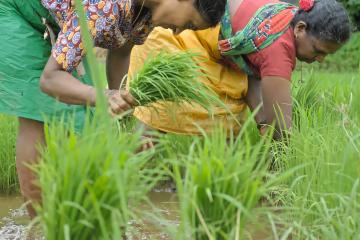
The Evidence Effect: Smarter development starts with evidence

Policymakers are facing a steep challenge: they need to address urgent development priorities with shrinking resources. This is especially pressing for low- and middle-income country governments. And recent events—from the dismantling of USAID and reduced aid commitments to declining economic growth—have deepened the strain.
Here’s a reason for optimism: Decades of rigorous evidence show that it’s possible to do more with less. If we make decisions about funding and scaling up policies based on what has been proven to work and what delivers more impact per dollar, limited resources will go further to reduce poverty and improve health, education, and economic opportunity for more people.
Many policymakers agree with this principle, and in recent years, more have started directing funding to programs with demonstrated impact. But in practice, most spending decisions are not informed by evidence. What do policymakers and evidence-to-policy organizations need to do to change the norm?
Fund programs that are effective and cost-effective to achieve more with less
Shifting spending to more effective and cost-effective development policies can dramatically improve people’s lives. Doing this means finding and scaling up cost-effective, evidence-informed approaches—and stopping or redesigning programs when they’re not working as intended.
To find these opportunities, policymakers can be guided by impact evaluations that measure whether a program works (effectiveness), and program cost data to calculate impact per dollar spent (cost-effectiveness).
In the past two decades, researchers in the J-PAL network alone have conducted over 2,500 ongoing or completed randomized impact evaluations of development and social programs, and built a growing library of cost-effectiveness analyses to help policymakers understand learning, health, or income gains from every dollar spent on a given program.
This evidence, combined with other key factors like local contexts and needs, policy priorities, and implementation capacity, has immense potential to lead to smarter decision-making—and has already had global impact. Research from our network has informed scale-ups of effective programs reaching over 850 million people around the world.
Examples of how evidence on impact and cost-effectiveness can inform development spending decisions
Through this work we’ve found many effective, cost-effective, and scalable development programs. In education, for instance, a method of tailoring instruction to students’ learning levels generates some of the largest learning gains per dollar out of a wide range of education programs. Giving parents and students the right information improves kids’ academic outcomes and is also inexpensive and highly scalable.
Some programs are highly cost-effective because they are cheap and deliver impact on a vast scale. Providing free deworming pills for school children and free preventive care products for families consistently demonstrate impressive value for money and reach hundreds of millions of people.
Other programs are more expensive per person but are cost-effective because they lead to large impacts that continue long after the program ends, like the Graduation approach, which empowers people to escape extreme poverty.
Ultimately, using evidence isn’t just about identifying winners. It’s about helping implementers learn, adapt, and deliver more for the people they serve. Randomized evaluations can also reveal that some promising programs do not work. That’s not failure; it’s essential learning. Evidence like this can help save money by not wasting resources on programs that don’t deliver as intended.
In Karnataka, India, for example, the state dropped a biometric monitoring program after research showed it wasn’t effective, saving hundreds of thousands of dollars. Evidence of limited impact also prompts evolution: microcredit has become more targeted and flexible; there are new cookstove designs that better match how people actually use them. And some early childhood programs show massive long-term gains for children when implemented at small scale, but not at large scale. As a result, implementers and researchers have been working together to identify and test better ways to run these programs at scale.
How can we shift the norm? Collect and share cost data, encourage evidence use in institutions, and collaborate with evidence-to-policy organizations
First, we need to invest more in collecting data about how much policies and programs cost to implement. While we’ve made huge progress measuring program impacts, we still know too little about how much programs cost—and how those costs change at scale or across contexts. Without cost data, it’s hard to compare options or decide what’s worth funding.
J-PAL is investing in tools to help policymakers close the gap: from creating detailed cost data templates, guidance, and other resources for implementers and researchers; to building a growing library of cost-effectiveness and welfare analyses to estimate how much return a government or implementer gets for each dollar spent on a program.
Second, we need to better support institutions that are committed to (or at least curious about) making evidence-informed decisions. Technical tools alone won’t drive a change in decision-making. Institutional commitments—like making evidence use part of program officers’ job descriptions and program terms of reference, or creating innovation units or funds that reward programs with larger grants after they demonstrate that they improve people’s lives—can go a long way in shifting the norm toward effective and cost-effective social spending.
We’ve seen promising shifts in this direction. The UK’s Foreign, Commonwealth and Development Office (FCDO), USAID, and other bilateral foreign assistance organizations have created chief economist offices to guide smart investments. Efforts like FCDO’s “Best Buys” recommendations and Strategic Impact Evaluation and Learning Programme and the independent Global Education Evidence Advisory Panel’s “Smart Buys” offer policy guidance grounded in rigorous evidence. The French government’s Fund for Innovation in Development and organizations like Givewell, Founders Pledge, Livelihood Impact Fund, and Prevail emphasize evidence-driven development investments. They all have shown how to enhance the effectiveness and value for money of development programs, and these times call for much greater movement in this direction.
The opportunity is now to invest in innovation, testing, and scaling programs with demonstrated impact, and to accelerate use of cost-effectiveness as a key factor in policy decisions.
We at J-PAL are here to help, whether by making evidence about effective and cost-effective programs more accessible and actionable; partnering with governments, NGOs, and funders to catalyze scale of effective programs; or supporting policymakers in establishing offices and funds to advance evidence-informed decision-making. By helping institutions use cost-effectiveness evidence, development spending can be smarter and make a greater difference in people’s lives.


